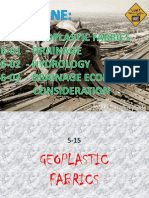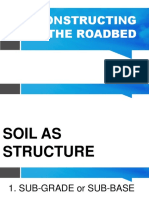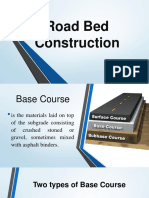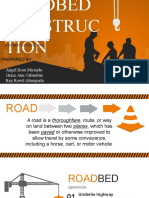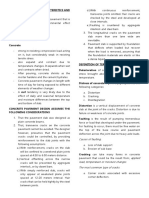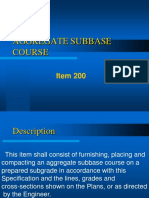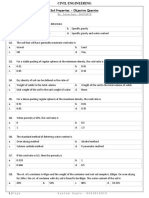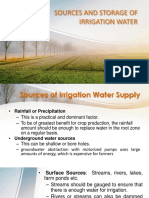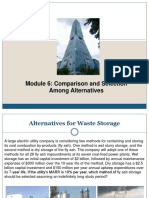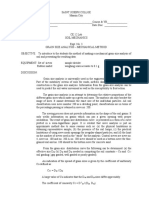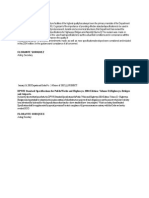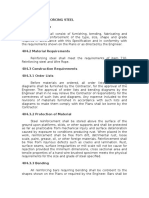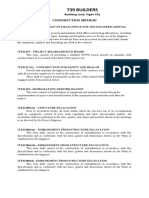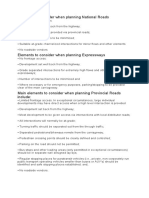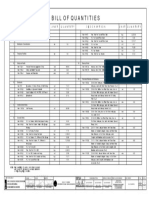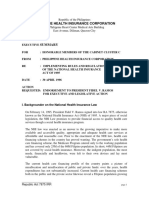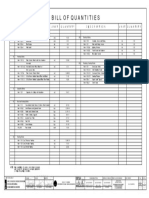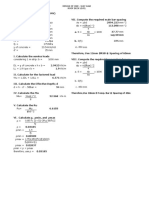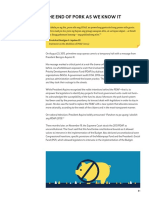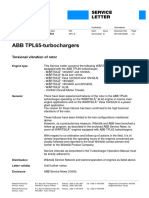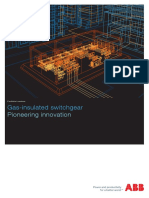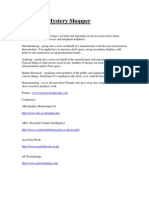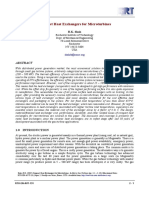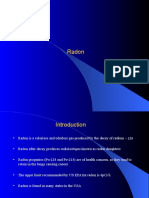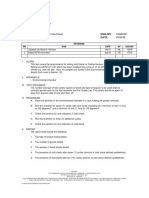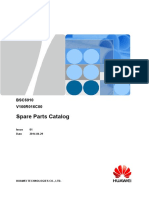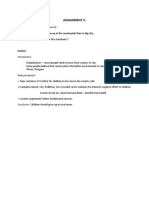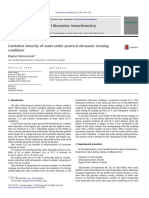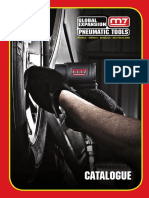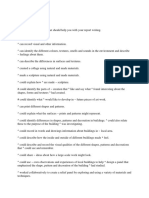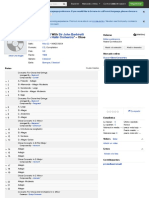2 Constructing The Roadbed WTH Assignments PDF
2 Constructing The Roadbed WTH Assignments PDF
Uploaded by
Angelo John R. JavinezCopyright:
Available Formats
2 Constructing The Roadbed WTH Assignments PDF
2 Constructing The Roadbed WTH Assignments PDF
Uploaded by
Angelo John R. JavinezOriginal Title
Copyright
Available Formats
Share this document
Did you find this document useful?
Is this content inappropriate?
Copyright:
Available Formats
2 Constructing The Roadbed WTH Assignments PDF
2 Constructing The Roadbed WTH Assignments PDF
Uploaded by
Angelo John R. JavinezCopyright:
Available Formats
CONSTRUCTING THE ROAD BED
Soil as Structure – with the long study of the unending road failures, road agencies have established a more detailed
procedure regarding the kind of materials to be used on a particular condition, type and behavior of the soil where the
road is to be constructed.
Three Major Structural Parts of Roadway:
1. The Sub-grade or sub-base is the earth or soil beneath the road, properly arranges and graded, compacted and
stabilized.
a.) Cut Section of Road – the sub-base is the original soil below the layers designated as the base
b.) Fill Section of Road – the sub-base consists of transported materials taken from nearby roadway cuts or
from borrow pit.
2. The Base Coarse – is the materials laid on top of the sub-grade or sub-base consisting of crushed stone or
gravel, sometimes mixed with asphalt binders.
3. The Pavement – is the materials laid over the base coarse base course consisting of Asphalt Concrete or
Portland Cement Concrete.
Sub-grade or Sub-base Coarse Aggregate is classified by DPWH as:
1. Item 200, Item 201, Item 202 which consist of furnishings, placing and compacting aggregate sub-base
coarse on a prepared sub-grade that differ from the grading requirements and conditions of the DPWH
standards.
2. Item 203 – Lime Stabilized Road Mix Base Coarse - consist of foundation for a surface coarse composed
of soil aggregate, lime and water proportion mixed on site and constructed on a prepared sub-grade or sub-
base.
3. Item 204 – Portland Cement Stabilized Road Mix Base Coarse – consist of a foundation for surface
composed of soil aggregate, Portland cement and water, proper proportions of road-mixed placed on a
prepared sub-grade or sub-base.
4. Item 205 – Asphalt Stabilized Road Mixed Base Coarse – Asphalt materials should be Anionic r Cationic
Emulsion asphalt of the slow setting type. The amount of asphalt material to be added to aggregate should
be from 4 to 7 mass percent of the dry aggregate.
5. Item 206 – Portland Cement Treated Plant Mix Base Coarse
a.) Travel Plant Mixing Method – new aggregate is pulverized at least 80 mass percent other than stone or
gravel.
b.) Central Plant Mixing Method – the plant is equipped with feeding and metering devices that will
introduce the cement aggregate and water into the mixer in quantities specified.
c.) Spreading, Compacting and Finishing – not more than 60 minutes should elapse from the start of
mixing to compaction of the laid mixture.
Types of Base Coarse
1. The granular base coarse or untreated soil mixture – it is a road surface of untreated soil mixture described
as gravel road
2. Treated base coarse – in order to stabilize the base coarse either asphalt, lime Portland cement or other
materials are mixed with the aggregates base coarse.
a.) Sand and Asphalt Base Coarse – composed of either loose beach sand, dune pit or river sand cemented
with asphalt materials.
b.) Fine Grain Asphalt Base – is an asphalt stabilized base and sub-grade constructed with fine grained has a
controlled Plastic Index of 6 to 10.
c.) Soil and Base Coarse Stabilized with Cement – cement stabilization y mixing natural materials and
Portland cement compacted at optimum moisture content and cured to hydrate the cement is considerably
strong and stable base.
Clearing and Grubbing is categorized by DPWH standard specifications as:
1. Item 100 – which consist of clearing, grubbing, removing and disposing of all vegetable matter and debris
except those objects that are designated to remain in place or are to be removed in consonance with other
provisions of the specifications.
2. Method of Measurement
a.) Area Basis – by hectare and fractions thereof acceptably cleared and grubbed.
b.) Lump Sum Basis – no measurement will be made
c.) Individual Unit Basis – selective clearing. Diameter of trees will be measured 1.4 meters above the
ground.
d.) Pay item designation according to schedule of sizes:
- Over 15 cm to 90 cm - Small
- Over 90 cm - Large
Excavation
The process of loosening and removing earth or rock from its original position in a cut and transporting it to a fill or
to waste deposit.
Classification of Road Excavation:
1. Unclassified excavation – excavation and disposal of all materials regardless of its nature, or not classified
and included in the Bill of Quantities under other pay item
2. Rock excavation – consist of rocks that cannot be excavated without blasting or use of rippers and all
boulders or other detached stones each having a volume of 1 cubic meter.
3. Common excavation – not included in the Bill of Quantities under rock excavation or other pay items.
4. Muck excavation – removal and disposal of saturated or unsaturated mixtures of soils and organic matter not
suitable for foundation materials regardless of moisture contents.
5. Borrow excavation – excavation and utilization of approved materials for the construction of embankment
Free Haul and Overhaul
Free Haul – is the specified distance wherein an excavated material will be hauled without additional cost,
usually 600 meters unless specified in the contract.
Overhaul – is an authorized hauling in excess of free haul distance.
Construction of Fill and Embankment
Fill - refers to a volume of earthen material that is placed and compacted for the purpose of filling in a hole or
depression.
Embankments or Fills - are constructed of materials that usually consist of soil, but may also include
aggregate, rock, or crushed paving material.
Construction
Stable embankment is attained by spreading the materials into thin layers then compacted at moisture content
closer to optimum.
Embankment Control
1. Specify the expected value and to ascertain from the fill density test that the specified amount is
obtained
2. Specify the manner and methods of constructing the embankment particularly the layer thickness,
moisture control and the number of passes by a roller of specified type and weight.
3. Use of proper spreading and compaction equipment
Construction Requirements & Equipment
1. Density test requirements
2. Moisture control
3. Compaction equipment
Compaction Equipment
1. Tamping Roller or compactor
2. Grid Roller
3. Pneumatic Tire Roller
4. Smooth Tired Roller
5. Vibratory Compactor
6. Bob Cat Compactor
Hauling Equipment
1. Pay loader
2. Backhoe
3. Dump truck
4. Trailer & Tractor
5. Bulldozer
6. Ready Mixed Concrete Truck
DPWH Specifications on Embankment is Item 104
1. Embankment shall be constructed of suitable materials
2. Must follow the construction method as specified
a.) Sods and vegetable matters must be removed for embankment below 120 cm below the sub-grade
b.) Loose volume of soil must be compacted not exceeding 20 cm before the next layer is placed
c.) Remove rocks greater than the thickness of the layers prescribed
d.) Hauling and leveling equipment should be routed and distributed over each layer of the fill to
make use of compaction efforts affording and to minimize rutting and uneven compaction.
3. Must conduct full-scale compaction trials on areas not less than 10 meters wide and 50 meters long,
before any work with the corresponding material is allowed to start.
4. Protection of Roadbed during construction it shall be maintained and drained at all times.
5. Rounding and Warping Slope - the top and bottom of all slopes including the slope drainage, ditches,
are rounded as planned. Warping slope in order to avoid injury to trees.
Sub-grade Preparation
Sub-grade preparation is categorized under Item 105 of the DPWH standard specifications.
Material requirements
1. Depth of sub-grade materials should be 15 cm or more
2. Prior to start of the sub-grade preparation, all culverts, cross drains, conduits and the like including
the backfill, ditches, drains and drainage outlets are thoroughly compacted.
Compaction and Stabilization
Materials placed in the sub-base should acquire the following properties:
1. The soil must have adequate strength
2. The soil must be relatively incompressible to avoid insignificant future settlement
3. The soil must be stable against volume change as water content or other factors vary
4. The soil must be durable and save against deterioration
5. The soil must possess proper permeability
CONSTRUCTING THE ROAD BED
Assignment
Semifinal Period
Research the usage, capacity and produce at least 2 pictures of the equipment listed below. Submit your
report in at least 2 pages of long size paper on Wednesday, Sept. 12, 2018.
Compaction Equipment
1. Tamping Roller or compactor - Homer Bartolay
2. Grid Roller - Ian Briones
3. Pneumatic Tire Roller - Norjel Contreras
4. Smooth Tired Roller - Angelo Javines
5. Vibratory Compactor - Waren Luzada
Hauling Equipment
7. Grader - Pearly Masangya
8. Pay loader - Franklin Mirana
9. Backhoe - Jan Noble
10. Dump truck - Christian Pabilando
11. Trailer & Tractor - Mark Sarol
12. Bulldozer - John Solo
You might also like
- Philippine National Standard - Portland Cement SpecificationDocument12 pagesPhilippine National Standard - Portland Cement SpecificationMariel Villaluna100% (2)
- DAY 1 MODULE - PDF CoshDocument34 pagesDAY 1 MODULE - PDF CoshAngelo John R. Javinez100% (1)
- Module 1 Conmatls Chapter 4Document10 pagesModule 1 Conmatls Chapter 4CARL JAMES100% (1)
- Geoplastic FabricsDocument35 pagesGeoplastic FabricsHerman Buenaflor BibonNo ratings yet
- PS2 4Document10 pagesPS2 4Karl Alexis TumibayNo ratings yet
- 6 - Concrete Re-BlockingDocument52 pages6 - Concrete Re-BlockingJane Bonggo100% (1)
- LG 37lf65-Zc Chassis Ld75a SMDocument59 pagesLG 37lf65-Zc Chassis Ld75a SMIonescu CristinaNo ratings yet
- Constructing The RoadbedDocument156 pagesConstructing The RoadbedLyka Isabel Tan0% (1)
- Construction of RoadbedDocument34 pagesConstruction of RoadbedJohn Mark TaborNo ratings yet
- DPWH Standard Specification on:COMPACTION AND STABILIZATIONDocument7 pagesDPWH Standard Specification on:COMPACTION AND STABILIZATIONAldever Bretana100% (1)
- Road Bed ConstructionDocument34 pagesRoad Bed ConstructionJek Yuson Junio100% (3)
- Angel Rose Miranda Grace Ann Cabanban Rey Rowil Almojuela: Prepared byDocument42 pagesAngel Rose Miranda Grace Ann Cabanban Rey Rowil Almojuela: Prepared byGrace Ann CabanbanNo ratings yet
- Constructing The RoadbedDocument15 pagesConstructing The RoadbedMoira Santos100% (1)
- Ce 113 - Concrete Pavement Behavior and CharacteristicsDocument12 pagesCe 113 - Concrete Pavement Behavior and CharacteristicsJacob John100% (3)
- Determination of Dry Unit Weight, Void Ratio and PorosityDocument2 pagesDetermination of Dry Unit Weight, Void Ratio and PorosityabegaelNo ratings yet
- DESCRIPTION: ITEM 405-Structural ConcreteDocument11 pagesDESCRIPTION: ITEM 405-Structural ConcreteKioNo ratings yet
- Sources of Potable WaterDocument5 pagesSources of Potable WaterIrene HugoNo ratings yet
- Item 200 AGGREGATE SUBBASE COURSEDocument15 pagesItem 200 AGGREGATE SUBBASE COURSEKEZIAH JANE SULAPASNo ratings yet
- Design of Surfaces and GuidewaysDocument50 pagesDesign of Surfaces and GuidewaysChristian Luares80% (5)
- Method - W MultiPurpose BLDG.Document2 pagesMethod - W MultiPurpose BLDG.lnicolas00No ratings yet
- Geotech Chapter 3 QuestionDocument3 pagesGeotech Chapter 3 Questiongautam100% (1)
- DO - 021 - s2017 Revised Guidelines BillboardpdfDocument2 pagesDO - 021 - s2017 Revised Guidelines Billboardpdfrubydelacruz100% (1)
- Make ShiftDocument6 pagesMake ShiftAnnamarie SanDiegoNo ratings yet
- Highway and Railroad EngineeringDocument30 pagesHighway and Railroad EngineeringNarte, Angelo C.No ratings yet
- Soil InvestigationDocument45 pagesSoil InvestigationMelano ArjayNo ratings yet
- Standard Specs (DPWH) PDFDocument3 pagesStandard Specs (DPWH) PDFArniel LaguardiaNo ratings yet
- 11 Macadam Asphalt MatDocument41 pages11 Macadam Asphalt MatLovely Mae Cruza GawinganNo ratings yet
- Chapter Three (Cont'd..) : Sight DistanceDocument17 pagesChapter Three (Cont'd..) : Sight DistanceEbisa AdamuNo ratings yet
- Constructing The Roadbed: Group 4: Capangpangan, JalikaDocument56 pagesConstructing The Roadbed: Group 4: Capangpangan, JalikaKrizza Joy Lintag CaspeNo ratings yet
- EMB 2012 Water Quality Status Report FinalDocument32 pagesEMB 2012 Water Quality Status Report Finalkazimirkira100% (1)
- CE602 MockboardQuiz2Document8 pagesCE602 MockboardQuiz2Najib A. CasanNo ratings yet
- ITEM 206-Report PavementDocument2 pagesITEM 206-Report PavementRaizen Roldan Babanto SomobayNo ratings yet
- Activity Report 2 (Soil Sampling) Fajardo Bsce3aDocument6 pagesActivity Report 2 (Soil Sampling) Fajardo Bsce3aGuilbert FajardoNo ratings yet
- Sources and Storage of Irrigation WaterDocument12 pagesSources and Storage of Irrigation WaterDC TVNo ratings yet
- D2488 - Description and Identification of Soils (Visual-Manual Procedure) PDFDocument11 pagesD2488 - Description and Identification of Soils (Visual-Manual Procedure) PDFNachoNo ratings yet
- Width of Widening of A Curve Section of RoadDocument21 pagesWidth of Widening of A Curve Section of Roadjdr100% (1)
- Dry Preparation of Disturbed SoilDocument2 pagesDry Preparation of Disturbed SoilJenny Ann ValderramaNo ratings yet
- 1.3 Asphalt Overlay On Existing PavementsDocument8 pages1.3 Asphalt Overlay On Existing PavementsNoel Malinao CablindaNo ratings yet
- Philex Ojt Group Report Group 2Document31 pagesPhilex Ojt Group Report Group 2Krist Jan Jimenez SeparaNo ratings yet
- Experiment 8 - FluidsDocument9 pagesExperiment 8 - FluidsJL CleofeNo ratings yet
- Module2-6 EEEDocument42 pagesModule2-6 EEE우마이라UmairahNo ratings yet
- Principles of Structural Analysis and DesignDocument1 pagePrinciples of Structural Analysis and DesigngellianforniasNo ratings yet
- ContractsDocument6 pagesContractsOnofre Algara Jr.No ratings yet
- Crack and Seat Presentation PDFDocument47 pagesCrack and Seat Presentation PDFrubydelacruzNo ratings yet
- Equipment and Apparatus For Testing: Cement 1. Blaine Air ApparatusDocument11 pagesEquipment and Apparatus For Testing: Cement 1. Blaine Air ApparatusGabriel VergaraNo ratings yet
- Design of PavementsDocument21 pagesDesign of PavementsDarlon CatibayanNo ratings yet
- QAPPDocument37 pagesQAPPcnmo1550% (2)
- Grain Size Analysis - Mechanical MethodDocument3 pagesGrain Size Analysis - Mechanical MethodRian BernanteNo ratings yet
- Design of Water Supply Project-Case Study - 1Document1 pageDesign of Water Supply Project-Case Study - 1John RomanusNo ratings yet
- Impacts of Hydrology in Civil Engineering Application of HydrologyDocument5 pagesImpacts of Hydrology in Civil Engineering Application of HydrologyAndrea MagtutoNo ratings yet
- Effects of Soils On Ground Motion Liquefaction Group 7 SexyDocument27 pagesEffects of Soils On Ground Motion Liquefaction Group 7 Sexyduaneadriancatedrillatabor100% (1)
- Tutorial 3Document2 pagesTutorial 3Irfan KhanNo ratings yet
- One-Storey Residential BuildingDocument1 pageOne-Storey Residential BuildingLawrence TuliaoNo ratings yet
- DPWH Standard SpecificationsDocument6 pagesDPWH Standard SpecificationsNiño Donayre Wariza100% (1)
- ITEM 404 - BluebookDocument4 pagesITEM 404 - BluebookEster MarianNo ratings yet
- Highway and Pavement ConstructionDocument35 pagesHighway and Pavement ConstructionCherylNo ratings yet
- C4 Sieve Analysis Aggregate Grading For Fine and Coarse AggregateDocument6 pagesC4 Sieve Analysis Aggregate Grading For Fine and Coarse AggregateDanial AsyraafNo ratings yet
- Construction Method BuildingDocument6 pagesConstruction Method BuildingLimuel PolisNo ratings yet
- Elements To Consider When Planning National RoadsDocument7 pagesElements To Consider When Planning National RoadsJoshua PhilNo ratings yet
- Constructing The Roadbed (BSCE3-EC1)Document6 pagesConstructing The Roadbed (BSCE3-EC1)Jayson J. PagalNo ratings yet
- Constructing The Roadbed (BSCE3-EC1)Document6 pagesConstructing The Roadbed (BSCE3-EC1)Jayson J. PagalNo ratings yet
- 7-4 Grading and Maintenance of Untreated SurfaceDocument10 pages7-4 Grading and Maintenance of Untreated SurfaceJobay Guden0% (1)
- Bill of Quantities: Six-Classrooms ADocument1 pageBill of Quantities: Six-Classrooms AAngelo John R. JavinezNo ratings yet
- Special Group Study 1: Inhinyero Review CenterDocument2 pagesSpecial Group Study 1: Inhinyero Review CenterAngelo John R. JavinezNo ratings yet
- Bill of Quantities: Xiii. Electrical WorksDocument1 pageBill of Quantities: Xiii. Electrical WorksAngelo John R. JavinezNo ratings yet
- Bill of Quantities: Four-Classrooms ADocument1 pageBill of Quantities: Four-Classrooms AAngelo John R. JavinezNo ratings yet
- Republic Act 7875 IrrDocument11 pagesRepublic Act 7875 IrrAngelo John R. JavinezNo ratings yet
- Homework 2 Projectile Motion Ans KeyDocument5 pagesHomework 2 Projectile Motion Ans KeyAngelo John R. JavinezNo ratings yet
- Bill of Quantities: Xiii. Electrical WorksDocument1 pageBill of Quantities: Xiii. Electrical WorksAngelo John R. JavinezNo ratings yet
- 3 Professional Practice of Civil Engineers (Revised Assignments 1)Document2 pages3 Professional Practice of Civil Engineers (Revised Assignments 1)Angelo John R. JavinezNo ratings yet
- RCD ProDocument80 pagesRCD ProAngelo John R. JavinezNo ratings yet
- B3. End of Pork UpdatedDocument9 pagesB3. End of Pork UpdatedAngelo John R. JavinezNo ratings yet
- Grand Theft AutoDocument1 pageGrand Theft AutoAngelo John R. JavinezNo ratings yet
- PBD Infra 4thed Ilog Covered CourtDocument95 pagesPBD Infra 4thed Ilog Covered CourtAngelo John R. JavinezNo ratings yet
- Sara MoyherDocument1 pageSara MoyherAngelo John R. JavinezNo ratings yet
- The Life of Manny Pacquiao: By: Shannon HoffmannDocument12 pagesThe Life of Manny Pacquiao: By: Shannon HoffmannAngelo John R. JavinezNo ratings yet
- The Rise and Fall of The Pacquiao Effect: Contrastive Priming and National IdentificationDocument23 pagesThe Rise and Fall of The Pacquiao Effect: Contrastive Priming and National IdentificationAngelo John R. JavinezNo ratings yet
- ABB TPL 65 Turbochargers - Torsional Vibration of RotorDocument4 pagesABB TPL 65 Turbochargers - Torsional Vibration of Rotorartemio CardosoNo ratings yet
- Gis PortefolioDocument12 pagesGis PortefolioruimauricioferreiraNo ratings yet
- NCN 14-2016 TR Code 1t2000eg0004 W.O RequestedDocument2 pagesNCN 14-2016 TR Code 1t2000eg0004 W.O RequestedMohamed HamedNo ratings yet
- En 1043-2 PDFDocument15 pagesEn 1043-2 PDFPana FlorinNo ratings yet
- Scaling Agile (Good!)Document70 pagesScaling Agile (Good!)Sun Sam Hwang100% (3)
- Become A Mystery ShopperDocument9 pagesBecome A Mystery ShopperLisa MyersNo ratings yet
- Digital Electronics-Synchronous CountersDocument7 pagesDigital Electronics-Synchronous CountersDivya Munigadapa100% (1)
- Compact Heat Exchangers For Microturbines: R.K. ShahDocument18 pagesCompact Heat Exchangers For Microturbines: R.K. Shah조기현No ratings yet
- Radon PowerpointDocument23 pagesRadon Powerpointokejomail100% (1)
- Rebuilding of Ahmadi Township Project - (PHASE 2-2) : SSL 4.495 MDocument1 pageRebuilding of Ahmadi Township Project - (PHASE 2-2) : SSL 4.495 Mأحمد حسنNo ratings yet
- Single and Double Volute Casing - RodeltaDocument3 pagesSingle and Double Volute Casing - Rodeltamasood_me60No ratings yet
- Strut - and - Tie Model For Analysis of Piles CapDocument8 pagesStrut - and - Tie Model For Analysis of Piles CapselvarajselvaaNo ratings yet
- FQ000001 Lacquer Cold CheckDocument1 pageFQ000001 Lacquer Cold CheckCarlos PerezNo ratings yet
- Open Im Score SetupDocument11 pagesOpen Im Score SetupHeglio Raines MunizNo ratings yet
- M.Sc. Integrated (5 Years) Degree Programmes (B.Sc. (3 Years) + M.Sc. (2 Years) )Document2 pagesM.Sc. Integrated (5 Years) Degree Programmes (B.Sc. (3 Years) + M.Sc. (2 Years) )RajiNo ratings yet
- ZFSC 2 372 S+Document1 pageZFSC 2 372 S+Anand RajNo ratings yet
- XML Dom CSSDocument20 pagesXML Dom CSSkool79No ratings yet
- Repro Times Talks About The Evolving World of Publishing Volume: 01 Issue: 01Document4 pagesRepro Times Talks About The Evolving World of Publishing Volume: 01 Issue: 01Repro India LimitedNo ratings yet
- Spare Parts Catalog: BSC6910 V100R016C00Document22 pagesSpare Parts Catalog: BSC6910 V100R016C00Kandasami SeeranganNo ratings yet
- Assignment 5:: Write An Esssay of About 300 WordsDocument6 pagesAssignment 5:: Write An Esssay of About 300 WordsMinh KhánhNo ratings yet
- Complementary and Supplementary Angles LP 2Document1 pageComplementary and Supplementary Angles LP 2api-267951281No ratings yet
- Implications of Globalisation For TVET CurriculumDocument8 pagesImplications of Globalisation For TVET CurriculumGakon100% (3)
- Ultrasonics Sonochemistry: Bogdan NiemczewskiDocument6 pagesUltrasonics Sonochemistry: Bogdan NiemczewskiOmid7686No ratings yet
- M7 CatalogDocument60 pagesM7 CatalogMarius QimNo ratings yet
- SS7 - Security - Beginner's GuideDocument18 pagesSS7 - Security - Beginner's Guideadil100% (2)
- Insulation Presentation - LucasDocument8 pagesInsulation Presentation - Lucasapi-502219083No ratings yet
- Usman Dan Fodio University, Sokoto - 1000130: Payer InformationDocument1 pageUsman Dan Fodio University, Sokoto - 1000130: Payer InformationOdunlami DamilolaNo ratings yet
- Art CommentsDocument2 pagesArt CommentsmerrufNo ratings yet
- Evelyn Rothwell With Sir John Barbirolli Conducting The Hallé Orchestra - Oboe Concertos (CD) at DiDocument2 pagesEvelyn Rothwell With Sir John Barbirolli Conducting The Hallé Orchestra - Oboe Concertos (CD) at Dimoromarino3663No ratings yet



